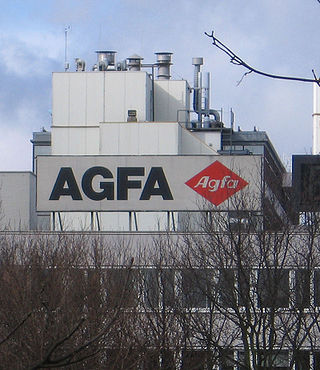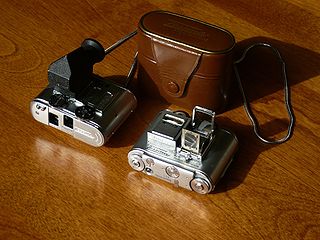
Film stock is an analog medium that is used for recording motion pictures or animation. It is recorded on by a movie camera, developed, edited, and projected onto a screen using a movie projector. It is a strip or sheet of transparent plastic film base coated on one side with a gelatin emulsion containing microscopically small light-sensitive silver halide crystals. The sizes and other characteristics of the crystals determine the sensitivity, contrast and resolution of the film. The emulsion will gradually darken if left exposed to light, but the process is too slow and incomplete to be of any practical use. Instead, a very short exposure to the image formed by a camera lens is used to produce only a very slight chemical change, proportional to the amount of light absorbed by each crystal. This creates an invisible latent image in the emulsion, which can be chemically developed into a visible photograph. In addition to visible light, all films are sensitive to X-rays and high-energy particles. Most are at least slightly sensitive to invisible ultraviolet (UV) light. Some special-purpose films are sensitive into the infrared (IR) region of the spectrum.

Agfa-Gevaert N.V. (Agfa) is a Belgian-German multinational corporation that develops, manufactures, and distributes analogue and digital imaging products, software, and systems.

Disc film is a discontinued still-photography film format that was aimed at the consumer market. It was introduced by Kodak in 1982.

ORWO is a registered trademark of the company ORWO Net GmbH, based in Wolfen and is also traditionally known for black-and-white film products, made in Germany and sold under the ORWO brand.

Subminiature photography is photographic technologies and techniques working with film material smaller in size than 35mm film, such as 16mm, 9.5mm, 17mm, or 17.5mm films. It is distinct from photomicrography, photographing microscopic subjects with a camera which is not particularly small.

An instant camera is a camera which uses self-developing film to create a chemically developed print shortly after taking the picture. Polaroid Corporation pioneered consumer-friendly instant cameras and film, and were followed by various other manufacturers.

In photography, reversal film or slide film is a type of photographic film that produces a positive image on a transparent base. Instead of negatives and prints, reversal film is processed to produce transparencies or diapositives. Reversal film is produced in various sizes, from 35 mm to roll film to 8×10 inch sheet film.

Instant film is a type of photographic film that was introduced by Polaroid Corporation to produce a visible image within minutes or seconds of the photograph's exposure. The film contains the chemicals needed for developing and fixing the photograph, and the camera exposes and initiates the developing process after a photo has been taken.

Agfacolor was the name of a series of color film products made by Agfa of Germany. The first Agfacolor, introduced in 1932, was a film-based version of their Agfa-Farbenplatte, a "screen plate" product similar to the French Autochrome. In late 1936, Agfa introduced Agfacolor Neu, a pioneering color film of the general type still in use today. The new Agfacolor was originally a reversal film used for making "slides", home movies and short documentaries. By 1939, it had also been adapted into a negative film and a print film for use by the German motion picture industry. After World War II, the Agfacolor brand was applied to several varieties of color negative film for still photography, in which the negatives were used to make color prints on paper. The reversal film was then marketed as Agfachrome. These films use Color Developing Agent 1 in their color developer.

The ADOX brand for photographic purposes has been used by three different companies since its original conception over one hundred fifty years ago. ADOX was originally a brand name used by the German company, Fotowerke Dr. C. Schleussner GmbH of Frankfurt am Main, the world's first photographic materials manufacturer. In 1962 the Schleussner family sold its photographic holdings to DuPont, an American company. DuPont used the brand for its subsidiary, Sterling Diagnostic Imaging for X-ray films. In 1999, Sterling was bought by the German company Agfa. Agfa did not use the brand and allowed its registration to lapse in 2003. Fotoimpex of Berlin, Germany, a company founded in 1992 to import photographic films and papers from former eastern Europe immediately registered the brand and today ADOX is a brand of black and white films, photographic papers and photochemistry produced by ADOX Fotowerke GmbH based in Bad Saarow near Berlin.

Ansco was the brand name of a photographic company based in Binghamton, New York, which produced photographic films, papers and cameras from the mid-19th century until the 1980s.
Polaroid Type 55 film is a black-and-white peel-apart Polaroid film that yields both a positive print and a negative image that can be used to create enlargements.

Harman Technology Limited, trading as Ilford Photo, is a UK-based manufacturer of photographic materials known worldwide for its Ilford branded black-and-white film, papers and chemicals and other analog photography supplies. Historically it also published the Ilford Manual of Photography, a comprehensive manual of everything photographic, including the optics, physics and chemistry of photography, along with recipes for many developers.
The following outline is provided as an overview of and topical guide to photography:

Analog photography, also known as film photography, is a term usually applied to photography that uses chemical processes to capture an image, typically on paper, film or a hard plate. These processes were the only methods available to photographers for more than a century prior to the invention of digital photography, which uses electronic sensors to record images to digital media. Analog electronic photography was sometimes used in the late 20th century but soon died out.
RA-4 is Kodak's proprietary name for the chemical process most commonly used to make color photographic prints. It is used for both minilab wet silver halide digital printers of the types most common today in photo labs and drug stores, and for prints made with older-type optical enlargers and manual processing.

Photographic film is a strip or sheet of transparent film base coated on one side with a gelatin emulsion containing microscopically small light-sensitive silver halide crystals. The sizes and other characteristics of the crystals determine the sensitivity, contrast, and resolution of the film. Film is typically segmented in frames, that give rise to separate photographs.













